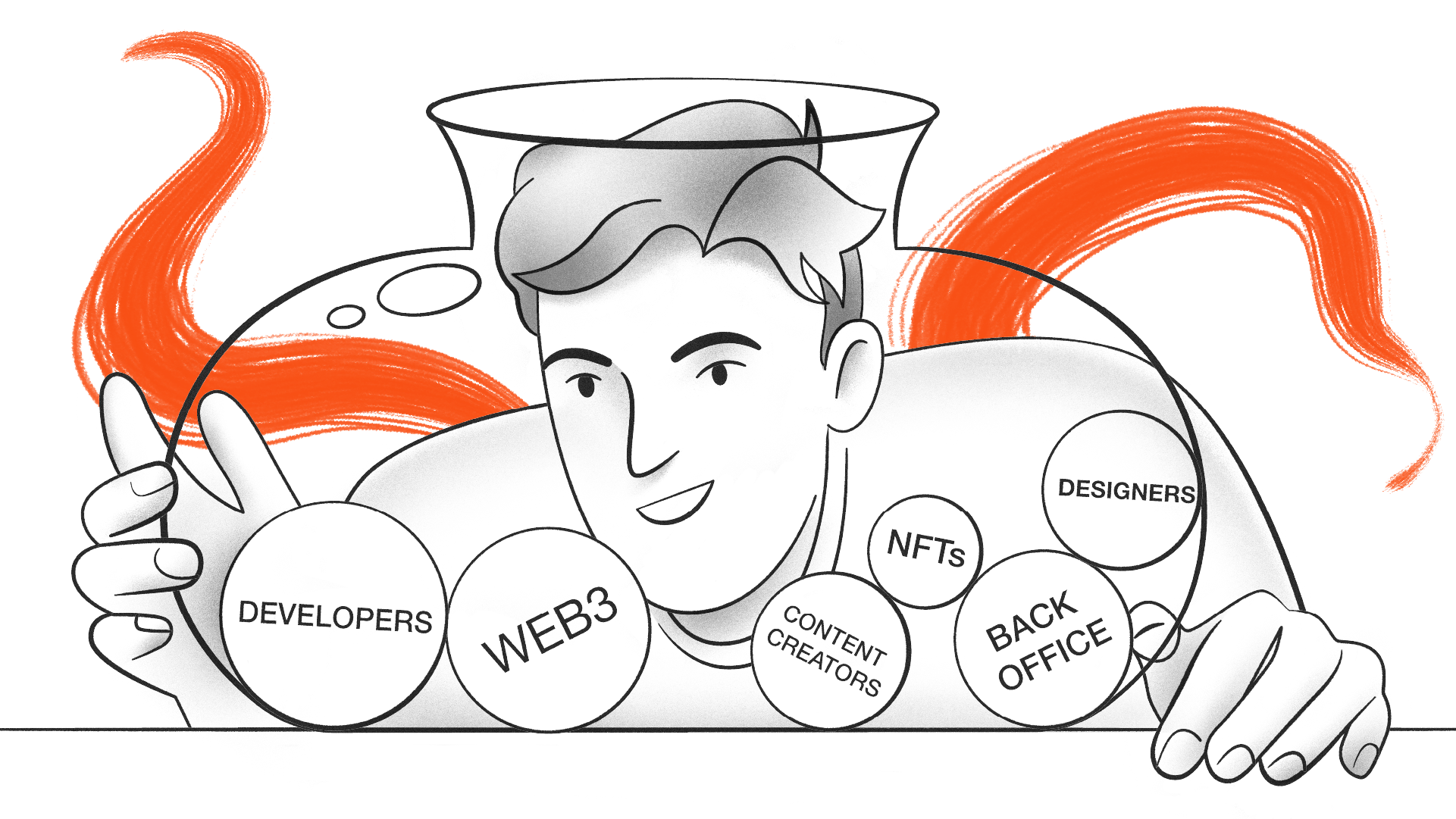
Embracing Change: HR in the World of Digital Assets
Hotcoin’s HR shares her journey from traditional industries to the world of Web3 and crypto, highlighting key insights on thriving in this space.
Read
‘Web3’ has become one of the big themes for the internet over the last couple of years, seeing huge interest and exponential growth as new technologies mature and come to fruition, enabling features and functionality that have never before been possible.
‘Web3’ has become one of the big themes for the internet over the last couple of years, seeing huge interest and exponential growth as new technologies mature and come to fruition, enabling features and functionality that have never before been possible.
But what is Web3, how does it differ from previous versions of the web, what opportunities are there to get involved – and is it really possible to build a whole new career in Web3?
Web3 is a new concept for the internet based on decentralised technologies and open culture. The term was coined in 2014 by Gavin Wood, the co-founder of Ethereum and founder of Polkadot and Kusama, who described it as ‘the "post-Snowden" web… a reimagination of the sorts of things that we already use the Web for, but with a fundamentally different model for the interactions between parties.’
Wood’s idea emphasises the need for trustless systems and privacy in a way that recalls the cypherpunk principles that underpinned the creation of Bitcoin. ‘Information that we assume to be public, we publish. Information that we assume to be agreed, we place on a consensus-ledger. Information that we assume to be private, we keep secret and never reveal. Communication always takes place over encrypted channels and only with pseudonymous identities as endpoints; never with anything traceable (such as IP addresses). In short, we engineer the system to mathematically enforce our prior assumptions, since no government or organisation can reasonably be trusted.’

However, it’s important to understand that – in keeping with its decentralised ethos – there is no single, universally-agreed definition of Web3. It is not based on a specific platform and was not launched by any given company. Instead, it is a natural evolution of the web that is being built by many different stakeholders, who agree on certain broad principles but may express and emphasise them in different ways.
In practice, Web3 is perhaps best understood by contrasting it with previous iterations of the web:
It’s worth stating at this point that Web3 is not a panacea to all the problems of Web2, and that a blockchain-based approach to web services has advantages and disadvantages. For example, Web3’s emphasis on the user’s self-sovereignty places the responsibility to manage personal data (including passwords and the private keys that control their crypto wallets) entirely with the individual. For less tech-savvy users, who are used to the convenience of Web2 platforms, this can be a significant burden.
There is also some skepticism around the overall idea of Web3, which has been criticised as being little more than a buzzword in some quarters. Tim Berners-Lee, the founder of the worldwide web, has openly questioned whether blockchain is necessary for a decentralised, privacy-centric version of the internet (despite selling an NFT for the original source code of the worldwide web for $5.4 million).
Fortunately, however, no one gets the final say about what Web3 actually is, or what form it should take. It is a collective undertaking that has almost as many expressions as it does applications and developers – many of which are, despite the skeptics, offering something qualitatively different and better than Web2 services.
Something that people often miss, or misunderstand, about Web3 is that it isn’t one specific thing. One of the skeptics’ biggest criticisms is that Web3 is hard to pin down; no two definitions seem to be the same. That’s because it’s a collection of disparate technologies and approaches – really more of a philosophy than anything else – that is being built by a grassroots community who are more concerned about upholding its core principles than they are about rigidly adhering to a top-down definition.
What matters most for a Web3 career, then, is a recognition of the value of decentralised technologies and the need to create a different kind of web to the one built by the centralised corporations of Web2.
All of the services delivered by Web2 will ultimately be provided by Web3, just in a different way. The ‘what’ is the same, but the ‘how’ is different. Perhaps the best example of this is DeFi, or decentralised finance: blockchain-based decentralised applications (dApps) that provide financial services such as token exchange, borrowing and lending, derivatives, stablecoin generation and more – all without the intermediaries that exist in the conventional financial system (along with their fees and conditions).
Web3 isn’t a complete departure from Web2. Lots of the same technologies are used in both, and someone who is familiar with building applications on Web2 will likely be able to transition into Web3 work without too much difficulty, depending on the role they’re pursuing. In some cases, the work will be almost identical; in other cases, you’ll need to find your way around new paradigms and programming languages, especially if you’re working directly with the blockchain layer of Web3.
To look at it a different way, in five or ten years most people won’t be talking about Web3. They will simply call it ‘the web’, just like regular users call it the web today, and not ‘Web2’. In this light, Web3 is as valid a career choice as any other career in web technologies – it’s all part of the same thing.
There are many, many opportunities available in the Web3 space. No matter what your skills and experience are, there will be a place for you if you are interested in joining the movement. Many of these roles will feel pretty familiar if you know your way around Web2 technologies and jobs.
Frontend developers. Just like any other web service, Web3 dApps need websites and user interfaces. While these might interface with the blockchain under the bonnet, on the surface they will look much like the regular Web2 services that billions of people use. Because blockchain can be kind of daunting for new users, the UX needs to be user-friendly, abstracting away as much of the complexity as possible. Good mobile apps and slick UIs have helped onboard millions of new users to Web3, and their importance can’t be underestimated.
Backend developers. Behind these user-friendly interfaces, dApps are hooked up to the blockchain. Backend devs will need to be familiar with how to use APIs to submit transactions, at the very least, and will need a keen appreciation for security. This is one of the roles where you might need to rethink your assumptions and grasp a whole new paradigm for the architecture applications run on.
Smart contract developers. Getting closer to the blockchain still, smart contract developers build decentralised applications (dApps) that actually run on the blockchain itself, using code that is executed trustlessly. You’ll need to know Solidity or another dedicated smart contract programming language, and know your way around various development tools. Smart contract devs are in short supply, so if you’ve got experience, there’s a good chance you can find a paid role.
NFTs. Non-fungible tokens are one of the key building blocks of Web3. While they rose to prominence as a means of trading digital art, they have far more diverse and exciting use cases – from custom financial assets to unique user identifiers and access passes to online services. Creating the functionality that powers these NFTs is a special case of smart contract development.
Metaverse. The metaverse has become one of the biggest themes and use cases for Web3. The metaverse is a collection of immersive, social online experiences, with built-in blockchain economies and NFTs providing ways of earning, collecting, and customising unique digital assets, from avatars to land, buildings and in-game items. Building the open platforms that enable users to create their own content is no mean feat, and there’s a lot of interest and investment going into metaverse applications (as shown by Facebook’s recent move to rebrand as Meta).
Graphic design. Artwork and graphic design have become a huge part of the Web3 experience. Digital art was the use case that popularised NFTs, and there is still a thriving art scene within the blockchain space. More than that, though, blockchain games and the metaverse have become heavily graphical, as they seek to provide rich, life-like user experiences. If you’re a competent designer, or have a talent for creating interesting art, there’s likely a job out there for you.
Marketing. Just like any other tech platform, Web3 applications need marketing and communications specialists to get the word out and bring in new users. You’ll be using the standard digital marketing techniques, including social media marketing (the crypto world revolves around social media platforms), and a few other approaches that are unique to Web3 culture.
Content creators. Again, like other tech projects, Web3 needs good content creators to communicate what can be complex ideas in a straightforward, engaging way. That might mean writing blogs and social media posts, working on documentation and white papers, making videos and infographics, or even coming up with good memes.
Community management. As the ‘read-write-own’ web, Web3 is built around large communities of users who share ownership of projects in some way – typically by holding project tokens or NFTs. These communities are generally open, and can consist of many thousands of people. They can need careful management to keep discussions on track, and to maintain reasonable standards of behaviour. Community management isn’t for the faint-hearted, but it’s an absolutely vital role if you’re going to get the most out of your user base.
Back office. Lots of Web3 platforms are built by regular companies with traditional structures. They operate just like other organisations, and have accounts and HR departments, as well as the development and marketing groups that might be more visible to outsiders. These companies need people with a gift for organisation and administration just as much as any other.
Legal and compliance. The Web3 space moves fast – faster than the speed of regulation, in most cases. That means you can be operating in an uncertain regulatory environment. Many Web3 organisations retain expert counsel or have in-house compliance officers to ensure they stick to best practices, where they are established, and position themselves wisely where the landscape is still unclear.
You won’t find too many conventional university or college courses on blockchain and Web3, though there are a few. The normal route into the Web3 world is more informal than that. The good news is that if you’re interested in becoming a Web3 developer or software engineer, there are plenty of resources out there to help you on your journey.
If you want to use your existing skills to work in Web3 then you shouldn’t find it too hard to make the transition; as discussed above, Web3 platforms need websites as interfaces just like Web2 ones. You may need to learn a little bit about blockchain, but the barriers are not significant.
If you want to build decentralised applications, on the other hand, then you will need to learn some new skills – including Solidity, the language used to build dApps on Ethereum, the most popular smart contracts platform.
To help you get started, you’ll find it easier if you’re familiar with one or more popular programming languages like Python or JavaScript, but it’s not strictly necessary. Solidity does not have a reputation for being a particularly difficult language and it’s very easy to get started. You’ll be building your first ‘hello world!’ app within a matter of hours or less. (Mastering dApp development, on the other hand, may take you many years, but let’s take it one step at a time.) More importantly, you’ll have a keen curiosity about these new technologies.
If you’re just starting out, you can find lots of beginner-level courses online. They tend to be very cheap, or even free – give FreeCodeCamp, Udemy or Coursera a try to see whether they suit you. If you want something less like a regular course, take a look at CryptoZombies, which teaches you to build an NFT collectibles game.
If you’re already proficient in one or more programming languages, you may well learn best by jumping in and just trying to write your own dApps. If you have specific questions, you should get some answers from forums like StackExchange Ethereum and StackOverflow. If you’re a member of any Discords or other social media communities in the DeFi or NFT spheres, then it can also be worth simply asking around – there are lots of people who will either be prepared to help, or who will point you in the right direction. Some projects even offer internship programmes.

Once you know what you’re doing, finding paid opportunities shouldn’t be too difficult. There are two main ways to do this:
Web3 is the big trend for the internet: a new generation of open, transparent, decentralised online services that put users back in control and help counter some of the worst excesses of Web2.
The Web3 movement is still in its infancy, and although there is enormous interest in it, there is no real consensus over what it might one day look like. This means there are not only some exciting opportunities, but the chance to shape the space from its inception.
Given the rapid growth of Web3 over the past two years, the demand for talent outstrips the supply of experienced candidates. If you’re looking for a new job or career, this works in your favour. The crypto world has always been meritocratic, and self-starters tend to do well: if you’re motivated to learn more about these technologies, have skills that you can use to build and promote new products, and are willing to work hard and take the initiative, you can likely forge a bright future in Web3.
Solidity is the main language used for smart contract development on Ethereum and EVM-compatible chains. If you’re looking at building dApps (applications that run on the blockchain) it’s a good idea to start here. However, many other popular programming languages are used in Web3 for a range of purposes, including Python, JavaScript, C++, HTML and CSS. Familiarity with any of these will be valuable.
Many of the skills you’ll need for Web3 are the same as you’d use in Web2, but they may be applied in a different way. If you want to get involved in Web3, then it will always be helpful to understand a little more about how blockchain technology works and some of the ways that decentralised systems differ from conventional Web2 platforms. If you want to go further down the rabbit hole – and especially if you want to start building dApps – then you’ll need some specific skills you won’t have acquired in Web2.
Web3 is a broad term that encompasses a range of decentralised technologies and approaches and, more than anything else, a philosophy of how the internet should be. If you think that openness, transparency, privacy, and user sovereignty and control of financial assets are important, and will be more prominent features of internet platforms and applications in the years to come, then you likely believe that Web3 is the future of the internet.
Alternatively, if you’re happy with the status quo of huge web corporations that exploit their users, sell their personal data, and control the information and services they have access to, you should probably stick to Web2.

Hotcoin’s HR shares her journey from traditional industries to the world of Web3 and crypto, highlighting key insights on thriving in this space.
Read
Discover how Web3 is reshaping HR practices with insights from a leading expert in the field.
Read
Discover Base's innovative L2 solution addressing scalability, security, and user experience challenges in crypto. Learn about Base Incubator by LaborX, fostering growth and innovation within the Base ecosystem.
Read